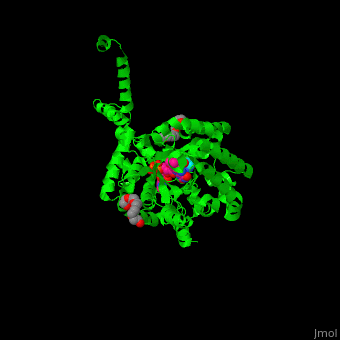Proline utilization A
From Proteopedia
(Difference between revisions)
| Line 1: | Line 1: | ||
| - | <StructureSection load='' size=' | + | <StructureSection load='' size='350' side='right' caption='E. coli PutA proline dehydrogenase domain with cofactor FAD complex with hydroxyproline (PDB code [[3e2q]])' scene='70/706260/Cv/1'> |
== Function == | == Function == | ||
'''Proline utilization A (PutA)''' is a bifunctional flavoprotein which acts as a transcriptional repressor of the put regulon or as a membrane-bound enzyme which catalyzes the oxidation of proline to glutamate. PutA domains include the DNA-binding domain (PRODH), the FAD-dependent proline dehydrogenase domain and the D-pyrroline-5-carboxylate dehydrogenase domain. The binding of proline to the PRODH active site and subsequent reduction of FAD causes a conformation change in PutA and enhance its membrane affinity. As a membrane-bound protein PutA switches from its repressor activity to its enzymatic role<ref>PMID:19994913</ref>. | '''Proline utilization A (PutA)''' is a bifunctional flavoprotein which acts as a transcriptional repressor of the put regulon or as a membrane-bound enzyme which catalyzes the oxidation of proline to glutamate. PutA domains include the DNA-binding domain (PRODH), the FAD-dependent proline dehydrogenase domain and the D-pyrroline-5-carboxylate dehydrogenase domain. The binding of proline to the PRODH active site and subsequent reduction of FAD causes a conformation change in PutA and enhance its membrane affinity. As a membrane-bound protein PutA switches from its repressor activity to its enzymatic role<ref>PMID:19994913</ref>. | ||
Revision as of 10:27, 26 August 2018
| |||||||||||
3D Structures of proline utilization A
Updated on 26-August-2018
References
- ↑ Srivastava D, Zhu W, Johnson WH, Whitman CP, Becker DF, Tanner JJ. The Structure of the Proline Utilization A Proline Dehydrogenase Domain Inactivated by N-Propargylglycine Provides Insight into Conformational Changes Induced by Substrate Binding and Flavin Reduction (,). Biochemistry. 2009 Dec 29. PMID:19994913 doi:10.1021/bi901717s
- ↑ Ostrander EL, Larson JD, Schuermann JP, Tanner JJ. A Conserved Active Site Tyrosine Residue of Proline Dehydrogenase Helps Enforce the Preference for Proline over Hydroxyproline as the Substrate (dagger) (double dagger). Biochemistry. 2009 Feb 10;48(5):951-9. PMID:19140736 doi:10.1021/bi802094k

